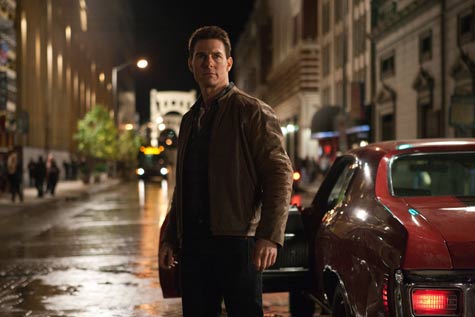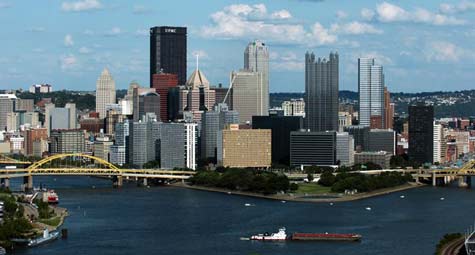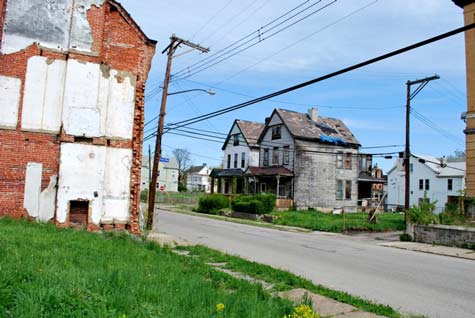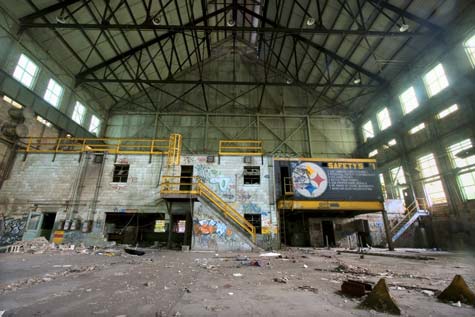 What do the recent films Unstoppable, The Dark Knight Rises, and Jack Reacher have in common? They were all primarily shot in Pittsburgh, Pennsylvania and environs. Why? Probably because of its undoubted cinematic appeal. Pittsburgh has a sprawling network of ethnic neighborhoods, steep hills and rolling streets, venerable buildings and parks, and the famous Three Rivers. Not to mention some handsome tax breaks provided by the state for today’s filmmakers.
What do the recent films Unstoppable, The Dark Knight Rises, and Jack Reacher have in common? They were all primarily shot in Pittsburgh, Pennsylvania and environs. Why? Probably because of its undoubted cinematic appeal. Pittsburgh has a sprawling network of ethnic neighborhoods, steep hills and rolling streets, venerable buildings and parks, and the famous Three Rivers. Not to mention some handsome tax breaks provided by the state for today’s filmmakers.
These same vivid, colorful traits (minus the tax breaks) hold true for a spate of recent novels, particularly mysteries and thrillers, set in the Steel City. Authors such as Kathleen George, Thomas Lipinksi, and K.C. Constantine have made good use of Western Pennsylvania’s unique flavors and tints, and of the cluster of small, industrially-depleted towns that surround the urban core.
I must admit, I’m prejudiced about Pittsburgh as a setting for mysterious goings-on. I was born and raised there, and graduated from Pitt. Though I’ve lived in Los Angeles for many years, the city still exerts a powerful pull on my memory. Which is why, when deciding on a setting for my own series of mystery thrillers, I chose my home town.

But not just for nostalgia’s sake. Pittsburgh’s an amazing place, an amalgam of old and new, a shot-and-a-beer town colliding with the Information Age. The steel mills I used to toil in during summers between college semesters are all gone; in their place are sleek, modern buildings where software designers and MBAs work. Run-down sections of the city have been gentrified, with the higher real estate values and tony shops that signify such startling changes. With its huge financial endowments—-from such fabled families as the Mellons, Carnegies, and Heinzs—-Pittsburgh’s become known as much for its state-of-the-art universities, museums and hospitals as for its sports teams. As well as its innovation. For example, it’s currently the world’s pioneer in nanotechnology.
In many ways, it truly represents the transformation of blue collar into white collar. Except that the vestiges of the old Pittsburgh I grew up in are still felt around the edges, still apparent in the weathered turn-of-the-century buildings, the ethnic neighborhoods, the immigrant values and loyalties.

Traits I know about all too well. As a child, my parents were horrified when they learned that, during lunch at school, I’d often trade my homemade fried eggplant sandwiches for more “American” peanut butter-and-jelly. Now, an adult visitor to Pittsburgh will find gentrified, trendy restaurants where similar classic Italian food is highly prized (and over-priced).
As mentioned, I worked for two summers at J&L Steel Works, part of seventeen miles of steel mills that no longer exist. Along with my fellow students, I wore the traditional yellow hard hat that marked me as a newbie. And made us a much more convenient target for the soda bottles, tuna fish cans and other refuse dropped on us from above by the crane operators. Part of the blue-collar way of life in the mill back in the sixties, as were the ethnically-separated work crews and the occasional visits by Teamsters, unloading “misplaced” goods from the backs of trucks. Then there were the longed-for breaks from the mill’s relentless heat, when, having fallen into an uneasy truce, we college kids and veteran mill hunks sat together on the tar-paper roof, overlooking the Monongahela River, drinking Cokes and listening to Pirates games on transistor radios.

For better or worse, that Pittsburgh, like its steel mills, is pretty much gone. No better example comes to mind than when my mother’s brain tumor was removed last year by a radical new surgery in a world-famous hospital unit, one of whose previous patients was the Dalai Lama. Part of a complex of new buildings—like so many springing up in the urban core—whose construction required the demolition of the older ones which had stood before.
No matter how welcomed or needed, change comes with a psychic cost. This is as true for a city as it is for an individual. I believe it’s certainly true for Pittsburgh. And it’s this tension between old and new, darkness and light, that makes it a fascinating place, and a great environment for a murder mystery.
As more and more authors are beginning to discover, as they lead their characters down the mean streets of Pittsburgh…
Skyline image via photographer Justin Merriman's blog. Image of Larimer neighborhood via ninety hoods. Steel mill image via Sean Posey's urban photoessay for Rustwire.
Formerly a Hollywood screenwriter (My Favorite Year; Welcome Back, Kotter, etc.), Dennis Palumbo is a licensed psychotherapist and author of Writing From the Inside Out. He also blogs regularly for The Huffington Post and Psychology Today. His mystery fiction has appeared in Ellery Queen’s Mystery Magazine, The Strand, and elsewhere, and is collected in From Crime to Crime. His acclaimed series of mystery thrillers (Mirror Image, Fever Dream, and the latest, Night Terrors), feature Daniel Rinaldi, a psychologist who consults with the Pittsburgh Police.

And with the Pirates winning, even better.
Didn’t Lenny and Squiggy meet at college there?
Thanks, Dennis, for bringing me home again…especially for that link to “ninety hoods” linking me up with my own. So, so far away, but yet always still with us, my friend. Great post, by a great writer!
Never been there but now I feel I have at least visited. Richness of detail brings your hometown vividly to life, Dennis.
I enjoyed reading this. I’ve lived in Southern California for the past nine years, but the article brought back many memories of my life in Pittsburgh. I used to live in the Shadyside area, right across the street from the hospital. The apartment building is gone now, and has been for quite some time. I later moved to the E. Liberty section, then finally to Westmoreland County, before eventually moving out west. Pittsburgh, and the surrounding suburbs, have their attributes. Kennywood Park, Station Square, The Point, The Mt. Washington incline and overlook. What a way to see the beautiful skyline! I wish that I’d taken a picture the last time I was up there. I’m starting to miss it. I sure don’t miss all of that summer rain, humidity, and the winter snow/ice. However, I am still, and always will be, a STEELER fan!